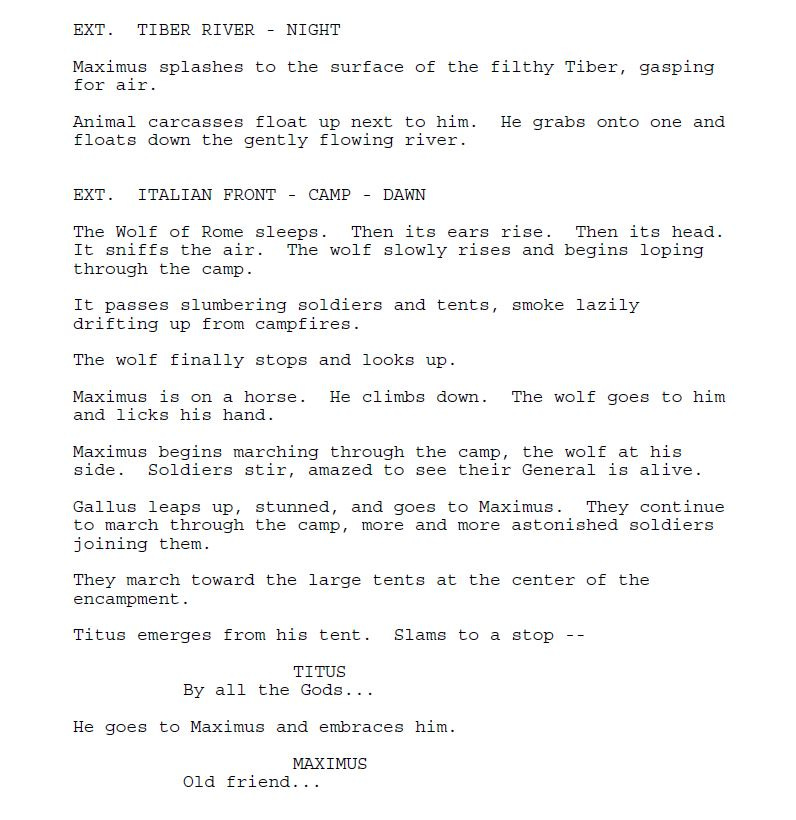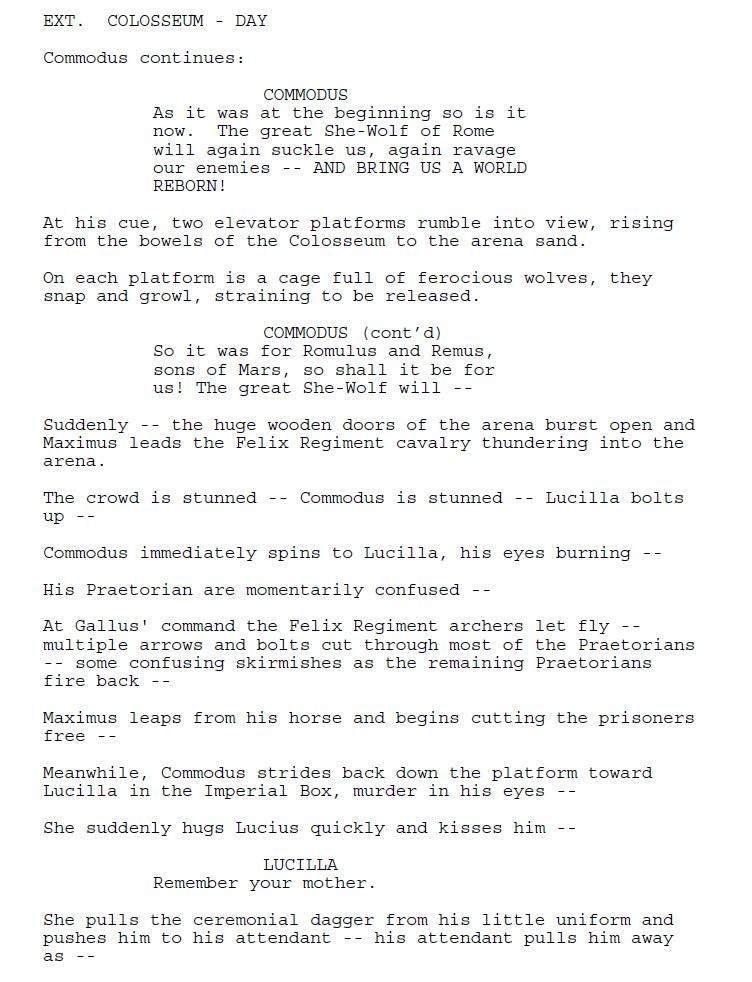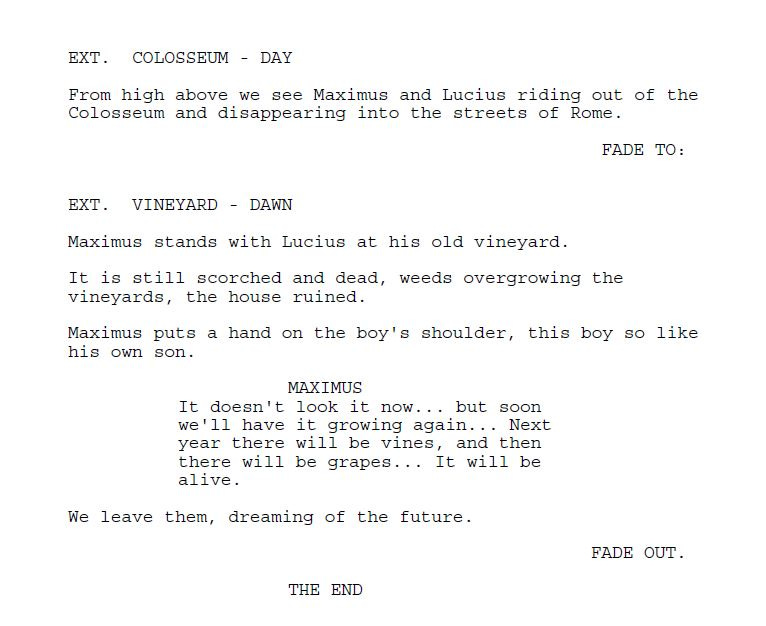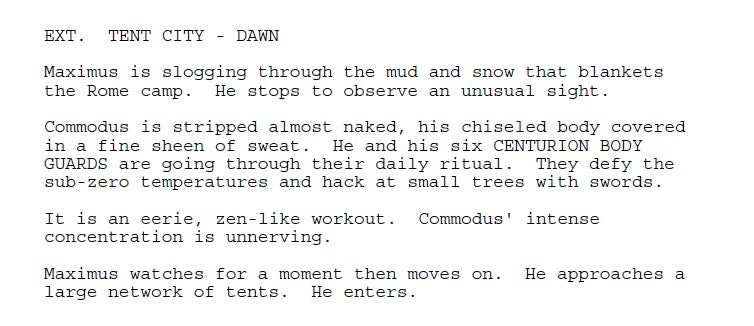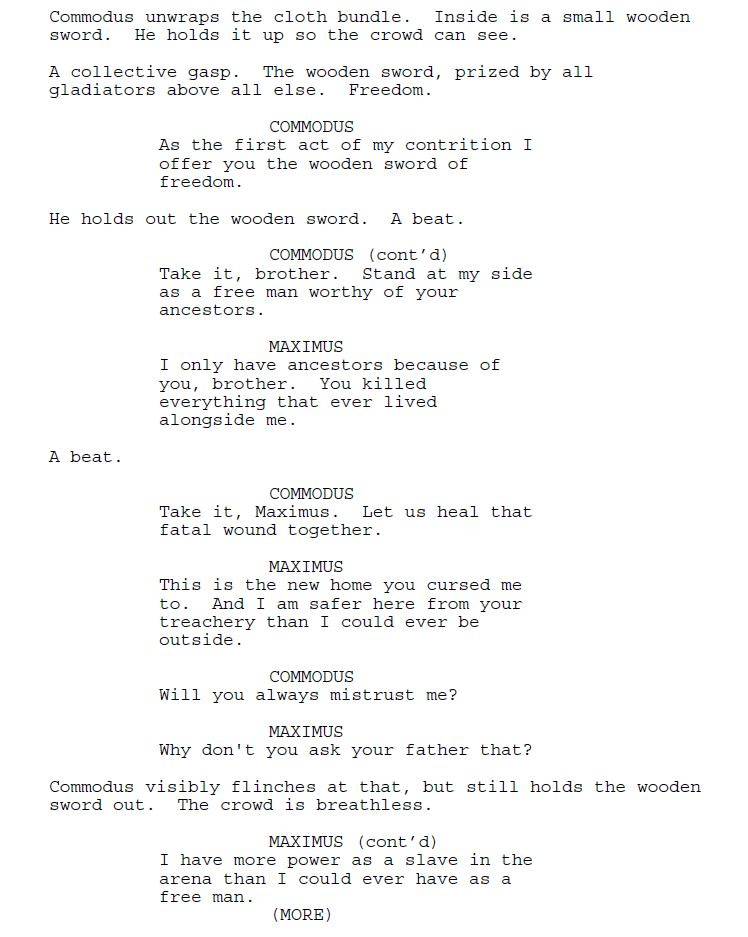Gladiator (2000) Script Review | #47 WGA 101 Greatest Scripts of the 21st Century
A decent if underwhelming tale that combines historical fact with the revenge story of Ben-Hur to mixed results.
Logline: A former Roman General sets out to exact vengeance against the corrupt emperor who murdered his family and sent him into slavery.
Written by: David Franzoni, John Logan and William Nicholson (note: this draft does not include Nicholson’s contributions)
Story by: David Franzoni
Pages: 120
If the final draft for Gladiator exists, I have not found it online; what we have instead is a second draft by David Franzoni and John Logan, without the contributions by William Nicholson. But even then, I regret to say that it is not a story I still particularly enjoyed.
As in the filmed version, this second draft traces the journey of Maximus, a falsely dishonored Roman general who winds up as a slave in the gladiator arena and swears revenge against the emperor who brought about this fate. It is a pure sword-and-sandals story. There is fighting, there is blood, and there is a sword, though no mention of sandals. In many respects, it conjures the spirit of Ben-Hur (the William Wyler version), a similar story about a man who falls from high due to treachery and returns to enact revenge on the culprit responsible.
The script opens with a battle in Germany. The year 180 A.D. The Roman Empire holds sway over all. Maximus wins the day and concludes his campaign, desiring nothing more than to retire to his vineyards (in the film, it is changed to wheat fields) and reunite with his wife and son. But Emperor Marcus Aurelius wants Maximus to be his successor— over his own son, Commodus. But Commodus refuses to sit idly by. Though it is not written (or shown as in the film), it is hinted that Commodus kills Aurelius. Destroying all evidence of his father’s intentions to name Maximus as emperor, Commodus condemns Maximus and his family to death. Maximus survives; his wife and son are crucified. Maximus is found by slavers, proves to be good with a sword, and begins to win the public with his prowess as a gladiator.
For the most part, this draft tracks with what wound up on the screen. It is in Act Three that the script diverges into a completely different ending. Instead of being captured and then publicly dueling Commodus one-on-one as it does in the film, Maximus escapes and marches his former army into Rome in time to rescue his captured gladiator compatriots.
He and Commodus battle under the Colosseum. Lucilla, the sister of Commodus who has been working all this time to undermine her brother, also dies…
… and in the end, Maximus leaves, taking her son, Lucius, as his own1.
Despite my lack of enthusiasm for Gladiator as a whole, changing Act Three was a smart move. This version feels clichéd in its eleventh-hour rescue—not to mention that the budget would have to be bigger to stage the final battle. Changing it to a single combat not only saves money, but creates an intimacy of its own. That it ends with the death of the hero due to a collapsing lung adds a tragic overtone to it all. William Nicholson was responsible for the afterlife plot that led to the death of Maximus; Nicholson also reworked the friendship between the gladiator and Juba, which is underbaked here, and also sanded the edges of the protagonist into a more sensitive character.
Something else that differs from the film is the portrayal of Commodus. Here, he is depicted as a warrior equal to Maximus, evidenced by his peculiar training and his physique…
… and his unerring aim with a spear.
He’s more tragic in this draft, and maybe even more pathetic. There is a scene that never made it to the film, in which Commodus publicly offers freedom to Maximus only to be humiliated when the gladiator rejects it.
Commodus is given a smidgen more sympathy than even Maximus, and that’s because the first draft centered around Commodus. In real life, Emperor Commodus was assassinated by a wrestler named Narcissus, and this idea lingers despite the revisions and changes.
A lot of script rewrites infamously plagued production, so it’s almost impossible to know which writer takes credit for what. But what we can be certain about is that it was Franzoni who came up with the idea for Gladiator first. An encounter in the 1970s with Daniel P. Mannix’s book, Those About to Die (The Way of the Gladiator), left a deep impression on Franzoni. Mostly, he was struck by the parallels of gladiators to modern-day sports stars and the adulation by sports fans. He’d spend the next two decades working his idea until he was in a position to pitch the script. When Sir Ridley Scott boarded as director, he hired Logan to polish the screenplay, finding Franzoni’s dialogue lacking subtlety. Logan would rewrite most of Act One and add the cruel fate of Maximus’ family to credibly increase the protagonist’s motivation for revenge.
Even with all the changes missing in this draft, I remain underwhelmed. Lucilla remains the most interesting character in Gladiator with her political acumen and maneuvering, while others like Proximo, Senator Gracchus, and Quintus (who is killed for betraying Maximus but survives in the film) feel underwhelming and underdeveloped. I guess I wasn’t that entertained after all.
Notes:
(March 30, 2020) | “I Want To See Movies About Lives People Have Led” David Franzoni Talks ‘Gladiator’ (Creative Screenwriting)
Falk, Ben (May 5, 2020) | 'Gladiator' at 20: Creator David Franzoni on the film's journey from 'Easy Rider' homage to Oscar hit (exclusive) (Yahoo Entertainment)
Interestingly, several ideas from this version— Maximus leading his army, Lucilla dying, the wooden sword of freedom— appear to have been reworked into the sequel. And you know what? I’m not ashamed to admit that I enjoyed Gladiator II more than its predecessor.


